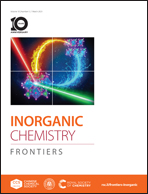A systematic investigation of the NMR relaxation properties of Fe(iii)-EDTA derivatives and their potential as MRI contrast agents†
Abstract
We report a detailed investigation of the potential of Fe(III) complexes with H4EDTA derivatives containing different spacers as magnetic resonance imaging (MRI) contrast agents: trans-cyclohexane-1,2-diamine (t-H4CDTA), cis-cyclohexane-1,2-diamine (c-H4CDTA), propane-1,3-diamine (H4PDTA), benzene-1,2-diamine (H4PhDTA), trans-cyclopentane-1,2-diamine (H4CpDTA) and trans-cyclobutane-1,3-diamine (H4CBuDTA). The Fe(III) complex of the related hexadentate ligand H2CBuDEDPA (6,6′-(((trans-cyclobutane-1,3-diyl)bis(azanediyl))bis(methylene))dipicolinic acid) is also reported for comparative purposes. The X-ray structure of [Fe(1,3-CBuDEDPA)](PF6)·H2O evidences the six-coordination of the ligand to the metal ion and displays a distorted octahedral polyhedron. All complexes show reversible or quasi-reversible cyclic voltammograms in aqueous 0.15 M NaCl due to the Fe(III)/Fe(II) pair, with E1/2 values in the range of +97 to 136 mV (vs. NHE) for the complexes with t-H4CDTA, c-H4CDTA, H4PhDTA and H4CpDTA. The longer spacers of H4PDTA and H4CBuDTA induce a stabilization of the Fe(II) complex (E1/2 = 260 and 294 mV vs. NHE, respectively). The Fe(III) complexes of H4PDTA and H4CBuDTA do not contain inner-sphere water molecules. Thus, their 1H nuclear magnetic relaxation dispersion (NMRD) profiles were analysed using an outer-sphere model. The complexes of c-H4CDTA and H4PhDTA display relaxivities that indicate the presence of a water molecule coordinated to the metal ion. A set of 17O NMR transverse relaxation rates and chemical shifts obtained at different temperatures provided information on the water exchange kinetics. Subsequently, the analysis of the 1H NMRD profiles provided information on the rotational dynamics of the complexes and electronic relaxation. The integrated approach reported here includes a computational DFT and CASSCF study and provides insights into the structural and dynamic parameters affecting the efficiency of these complexes as MRI contrast agents.



 Please wait while we load your content...
Please wait while we load your content...